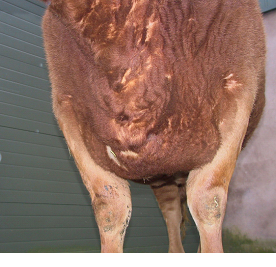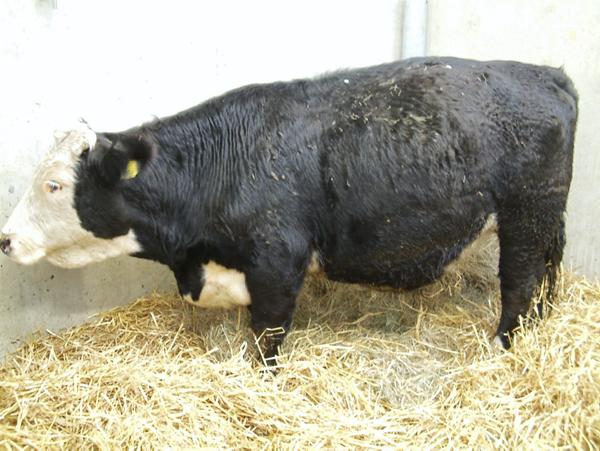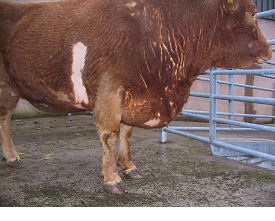Cattle seem to be the species that is most susceptible to high altitude disease and the condition exists mostly in the Rocky Mountain region of Wyoming and Colorado with smaller areas in New Mexico as well as Montana. Swelling may spread up the neck or under the belly.

Brisket Disease Research Continues Tsln Com
The disease is commonly called brisket disease due to the added fluids which would build up in the brisket and belly regions of the cattle says Frank Garry professor in the Department of Clinical Sciences Integrated Livestock Management at Colorado State University CSU.

How to treat brisket disease in cattle. The value of recognizing brisket disease. Neary says it can be extremely hard to differentiate between the early stages of brisket disease and respiratory disease. Holt also teaches ranchers how to treat cattle affected by HMD by draining the pleural effusion out of the animals cavity.
Vaccination with the improved type of adjuvant vaccine carried out about a month before the onset of rains will protect animals against the attack of the disease for about one year. High altitude disease also known as brisket disease is a condition predominantly in cattle that occurs in a percentage of cattle maintained and managed above 6000 feet. Unless the condition is reversed the animal dies.
Without treatment accumulation of this fluid causes rapid heart failure. The essential oils that have proved in vitro a more active effect towards a positive and efficient modulation of rumen fermentation are garlic cinnamaldehyde the most important active compound of cinnamon eugenol active compound of the flowers not yet budded and dried of Eugenia caryophyllata commonly called cloves capsicum the active compound of red pepper and. A year later the bull scored 118.
Brisket disease can become very costly unless any new animals brought into these herds can be tested in order to predict which ones might suffer. Calves presenting with signs of pneumonia may actually have brisket disease pneumonia or both. Low oxygen saturation in the air leads to pulmonary hypertension with subsequent edema in ventral tissues of the chest and abdomen.
In areas of higher elevation some cattle suffer pulmonary arterial hypertension which leads to congestive heart failure. Treatment typically requires movement to lower elevation and prevention through selective breeding for resistant stock is often preferred. In both diseases calves may have a rough hair coat droopy ears high breathing rate sluggishness and glazed eyes.
Holt also teaches ranchers how to treat cattle affected by HMD by draining the pleural effusion out of the animals cavity. High mountain disease brisket disease is right heart failure due to hypoxic pulmonary hypertension in cattle residing at high altitudes13 Hypoxia is the most potent stimulus for pulmonary hypertension and the hypoxia of high altitude 7000 ft is a well known cause48 Some cattle Bos taurus possess a heritable susceptibility to severe high-altitude pulmonary hypertension HAPH912 While most cattle thrive at high altitudes susceptible cattle. Holt asked the owner for the bull and he declined as the bull was out of Traveler 23-4 which Holt said is his favorite bull.
This fluid results from congestive right heart failure. Animals that are affected by brisket disease are usually lethargic and develop edema swelling in the neck and brisket due to high blood pressure forcing fluid out of the vessels into surrounding tissues. Brisket disease per se generally only appears in cattle above 5000 feet with 7500 feet and higher being more critical.
In efforts to cut losses to Brisket Disease cattlemen should identify those animals specifically bulls with high pulmonary arterial pressures and cull them from the herd to avoid adding them to the herd. This indicates that cattlemen can successfully select against the disease by culling cattle with high pulmonary arterial pressures. Garry and other CSU researchers including Tim Holt associate professor of livestock medicine and surgery have assisted ranchers in developing selection and testing techniques to reduce the incidence of brisket.
Cattle in Colorado for instance are often grazing at 9000 to 12000 feet. This condition has been called brisket disease mountain sickness big bris. This fluid results from congestive right heart failure.
Short course of the disease and its termination in sudden death animals are seldom available in good time for treatment. Several years ago Tim Holt DVM said he PAP tested a bull that scored a 96 at 7 months of age. Without treatment accumulation of this fluid causes rapid heart failure.
Treatment of Brisket Disease in cattle The best treatment for an animal with brisket-disease symptoms is to immediately take it to lower elevation or treat it in a hyperbaric chamber where oxygen concentration can be greatly increased to simulate lower elevation says Tim Holt Colorado State University DVM.

Bovine High Mountain Disease Circulatory System Merck Veterinary Manual

Brisket Disease Is Not Just An Altitude Issue Top Headlines Wlj Net

Oedema Of The Submandibular Region And Brisket And Distended Jugular Download Scientific Diagram

Brisket Disease Is Not Just An Altitude Issue Top Headlines Wlj Net

Nadis National Animal Disease Information Service

Treating Hardware Disease In Cows 18 January 2015 Free

Brisket Disease In Cattle 2018 Youtube

Nadis National Animal Disease Information Service
Brisket Disease Research It S Not Just A High Altitude Disease
0 comments:
Post a Comment